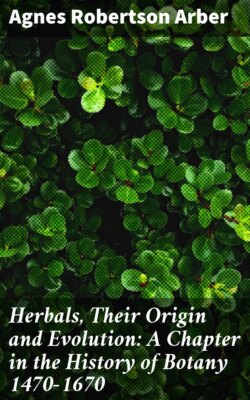Herbals, Their Origin and Evolution

Реклама. ООО «ЛитРес», ИНН: 7719571260.
Оглавление
Agnes Robertson Arber. Herbals, Their Origin and Evolution
Herbals, Their Origin and Evolution
Table of Contents
CHAPTER I. THE EARLY HISTORY OF BOTANY
1. Introductory
2. Aristotelian Botany
3. Medicinal Botany
CHAPTER II. THE EARLIEST PRINTED HERBALS
1. The Encyclopædia of Bartholomæus Anglicus and ‘The Book of Nature.’
2. The Herbarium of Apuleius Platonicus
3. The Latin Herbarius
4. The German Herbarius and related Works
5. The Hortus Sanitatis
CHAPTER III. THE EARLY HISTORY OF THE HERBAL IN ENGLAND
1. The Herbarium of Apuleius Platonicus
2. Banckes’ Herbal
3. The Grete Herball
CHAPTER IV. THE BOTANICAL RENAISSANCE OF THE SIXTEENTH AND SEVENTEENTH CENTURIES
1. The Herbal in Germany
2. The Herbal in the Low Countries
3. The Herbal in Italy
4. The Herbal in Switzerland
5. The Herbal in France
6. The Herbal in England
7. The Revival of Aristotelian Botany
CHAPTER V. THE EVOLUTION OF THE ART OF PLANT DESCRIPTION
CHAPTER VI. THE EVOLUTION OF PLANT CLASSIFICATION
CHAPTER VII. THE EVOLUTION OF THE ART OF BOTANICAL ILLUSTRATION
CHAPTER VIII. THE DOCTRINE OF SIGNATURES AND ASTROLOGICAL BOTANY
CHAPTER IX. CONCLUSIONS
APPENDIX I
APPENDIX II
FOOTNOTES:
INDEX
Отрывок из книги
Agnes Robertson Arber
A Chapter in the History of Botany 1470-1670
.....
FTER the invention of printing, a very active period of book production followed, during which many works, which had previously passed a more or less lengthy existence in manuscript, were put into circulation in print, contemporaneously with books actually written at the time. The result is that a number of the “incunabula,” as printed books of the fifteenth century are technically called, are far more ancient, as regards the matter which they contain, than the date of their publication would seem to suggest.
This characteristic is illustrated in the Encyclopædia of Bartholomæus Anglicus, and in Konrad von Megenberg’s ‘Das půch der natur,’ which were perhaps the earliest printed books containing strictly botanical information. The former work, which was first printed about 1470, was compiled by a monk, sometimes called Bartholomew de Glanville, who flourished in the thirteenth century. The title by which it is generally known is ‘Liber de proprietatibus rerum.’ One of the sections of which it is composed is concerned with an account of a large number of trees and herbs, arranged in alphabetical order, and is chiefly occupied with their medicinal properties. It also includes some theoretical considerations about plants, on Aristotelian lines. An English translation, which was printed by Wynkyn de Worde before the end of the fifteenth century, is interesting as containing the very primitive botanical wood-cut reproduced in Text-fig. 19.
.....